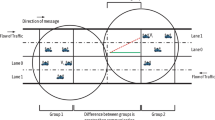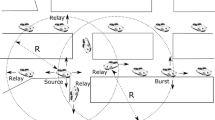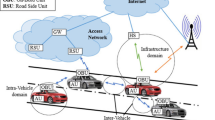Abstract
Location determination is one of the most difficult tasks to be achieved in Vehicular Ad Hoc networks (VANETs), as the nodes change their positions quickly due to high velocity. So, data dissemination to the vehicles in presence of high node mobility is one of the challenging issues to be resolved. To address these issues, in this paper, we propose a new Replication-Aware Data Dissemination (RADD) scheme for VANETs by estimating the location of the nodes. Separate algorithms are designed for position estimation, accessing the message from the remote vehicles, and route the packets to the destination. Also, vehicles on the road are sparsely distributed in some regions, so finding an appropriate vehicle for replica placement is also difficult as it needs a specialized approach. To search the suitable vehicle for replica placement, Bloom filters are used using which searching becomes fast and improves the overall performance of the system. Moreover, passive RFID tags are used on the vehicles and the RFID readers are placed on the RSUs to collect the data from these tags. These tags and readers are used to determine the vehicles positions in short range communication where GPS system does not work well. Hence, in the proposed scheme, there is no need of placement of access points on the either side of the road which reduces the complexity of the message dissemination in the proposed scheme. The complexity analysis of the proposed scheme is evaluated in different network conditions with respect to data dissemination from source to destination. The performance of the proposed scheme was evaluated using different evaluation metrics in comparison to the other existing state-of-the-art schemes. The results obtained show that the proposed scheme performs better than the other existing schemes of its category with respect to various metrics. Specifically, there are improvements of 18 % in reliability, 27 % in replication cost, and 7 % in PDR with respect to the existing state-of-art protocols.














Similar content being viewed by others
References
Ghafoor KZ, Mohammed MA, Lloret J, Bakar KA, Zainuddin ZM (2013) Routing protocols in vehicular ad hoc networks: survey and research challenges. Netw Protoc Algorithm 5(4):39–83
Dua A, Kumar N, Bawa S (2014) A systematic review on routing protocols for vehicular ad hoc networks. Veh Commun 1(1):33–52
Kumar N, Chilamkurti N, Rodrigues J JPC (2014) Learning automata-based opportunistic data aggregation and forwarding scheme for alert generation in vehicular ad hoc networks. Comput Commun 59(1):22–32
Bali RS, Kumar N, Rodriques J JPC (2014) Clustering in vehicular ad hoc networks: Taxonomy challenges and solutions. Veh Commun 1(3):134–152
Kumar N, Chilamkurti N (2014) Collaborative trust aware Intelligent Intrusion Detection System in VANETs, 2014. Comput Electr Eng 40(6):1981–1996
Kumar N, Lee JH (2013) Peer-to-Peer cooperative caching for data dissemination on urban vehicular communications. IEEE Syst J. doi:10.1109/JSYST.2013.2285611
Kumar N, Chilamkurti N, Park JH (2013) ALCA: agent learning-based clustering algorithm in vehicular ad hoc networks. Pers Ubiquit Comput 17(8):1683–1692
Chen YS, Lin YW, Pan CY (2011) DIR: diagonal-intersection-based routing protocol for vehicular ad hoc networks. Telecommun Syst 46(4):299–316
Kumar N (2014) Misra S. IEEE Systems Journal. doi:10.1109/JSYST.2014.2335451.
Kumar N, Lee J-H, Rodrigues JPC (2014) Intelligent Mobile Video Surveillance System as a Bayesian Coalition Game in Vehicular Sensor Networks: Learning Automata Approach. IEEE Trans Intell Transp Syst. doi:10.1109/TITS.2014.2354372
Garmehi M, Analoui M, Pathan M, Buyya R (2014) An economic replica placement mechanism for streaming content distribution in Hybrid CDN-P2P networks. Comput Commun. doi:10.1016/j.comcom.2014.06.007
Ahmadifard N, Nabizadeh H, Abbaspour M (2014) ISEFF: An ID-based scalable and efcient distributed file sharing technique in vehicular ad hoc networks. Wirel Pers Commun 75(2):821– 841
Dias J AFF, Rodrigues J JPC, Isento JN, Pereira P RBA, Lloret J (2011) Performance assessment of fragmentation mechanisms for vehicular delay-tolerant networks. EURASIP J Wirel Commun Netw 2011(195):1–14
Chen YS, Lin YW (2012) A mobicast routing protocol with carry-and-forward in vehicular ad hoc networks. Int J Commun Syst. doi:10.1002/dac.2404
Xia F, Ahmed AM, Yang LT, Ma J, Rodrigues JPC (2013) Exploiting social relationship to enable efficient replica allocation in adhoc social networks. IEEE Trans Parallel Distrib Syst. doi:10.1109/TPDS.2013.2295805
Ou CH (2014) A roadside unit-based localization scheme for vehicular ad hoc networks. Int J Commun Syst 27(1):135–150
Saritha V, Viswanatham VM (2013) An efficient cross layer based channel reservation method for vehicular networks. doi:10.1002/dac.2609
Babu AV, Ajeer VKM (2013) Analytical model for connectivity of vehicular ad hoc networks in the presence of channel randomness. Int J Commun Syst 26(7):927–946
Xiaonan W, Huanyan Q (2012) Constructing a VANET based on cluster chains. Int J Commun Syst. doi:10.1002/dac.2484
Slavik M, Mahgoub I, Alwakeel M (2014). Int J Commun Syst. doi:10.1002/dac.2799
Li C , Zhao C, Zhu L, Lin H, Li J (2013) Geographic routing protocol for vehicular ad hoc networks in city scenarios: a proposal and analysis. Int J Commun Syst. doi:10.1002/dac.2602
Chen YS, Hsu CS, Cheng CH (2013) Network mobility protocol for vehicular ad hoc networks. Int J Commun Syst. doi:10.1002/dac.2525
Zhang J, Xu Y (2013) Privacy-preserving authentication protocols with efficient verification in VANETs. Int J Commun Syst. doi:10.1002/dac.2566
Alawi MA, Saeed RA, Hassan AA, Alsaqour RA (2013) Simplified gateway selection scheme for multihop relay in vehicular ad hoc network. Int J Commun Syst. doi:10.1002/dac.2581
Oh S, Gruteser M, Pompili D (2012) Coordination-free Safety Messages Dissemination Protocol for Vehicular Networks. IEEE Trans Veh Technol. doi:10.1109/TVT.2012.2197871
Mershad K, Artail H (2013) Finding a STAR in a vehicular cloud. IEEE Intell Transp Syst Mag 5(2):55–68
Liang H, Cai LX, Huang D, Shen X, Peng D (2012) An SMDP-based service model for interdomain resource allocation in mobile cloud networks. IEEE Trans Veh Technol 61(5):2222–2232
Ibrahim WM, Taha AEM, Hassanein HS (2014) Using smart vehicles for localizing isolated Things. Comput Commun
Trindade J, Vazao T (2014) Routing on large scale mobile ad hoc networks using bloom filters. Ad Hoc Networks. doi:10.1016/j.adhoc.2014.05.016
Sultan SA, Doori MMA, Bayatti AHA, Zedan H (2014) A comprehensive survey on vehicular Ad Hoc network. J Netw Comput Appl 37:380–392
Aslam B, Wang P, Zou C (2008) An economical deployable and secure vehicular ad hoc network. In: Proceedings of Military Communication Conf., San Diego, CA, 2008, pp 1–7
Kafsi M, Papadimitratos P, Doussey O, Alpcanz T, Hubaux JP (2008) VANET connectivity analysis, EPFL/T-Labs. Tech. Rep, Switzerland
Mohandas BK, Nayak A, Niak K, Goel N (2008) ABSRP-A service discovery approach for vehicular ad-hoc networks. In: Proceedings of 3rd IEEE Asia Pacific Services Computing Conference, Pisa, Italy, December 2008, pp 1590–1594
Yang P, Wu W, Moniri M, Chibelushi CC (2013) Efcient Object Localization Using Sparsely Distributed Passive RFID Tags. IEEE Trans Ind Electron 60(12):5914–5924
Jerbi M, Senouci SM, Meraihi R, Doudane YG (2007) An Improved Vehicular Ad Hoc Routing Protocol for City Environments. In: Proceedings of IEEE International Conference on Communications, ICC ’07, Glasgow, Scotland, June 2007
Liu G, Lee BS, Seet BC, Foh CH, Wong KJ, Lee KK (2004) A routing strategy for metropolis vehicular communications. In: Proceedings of International Conference on Information Networking (ICOIN), Busan, Korea, February 2004
Zhao T, Liu Z, Yan W, Li X (2011) BFBD: A Bloom filter based Buffering Data Dissemination Algorithm for Vehicular Ad hoc Networks. In: Proceedings of IEEE Consumer Communications and Networking Conference (CCNC), Las Vegas, USA, pp 477–481
SUMO Simulation of Urban Mobility. [Online]. Available: http://sumo.sourceforge.net/
NS2.35. [Online]. Available: http://www.isi.edu/nsnam/ns/
Dua A, Kumar N, Bawa S, Chilamkurti N (2013) Efficient TDMA based Virtual Back off Algorithm for Adaptive Data Dissemination in VANETs. In: Procedings of International Symposium of Wireless and Pervasive Computing Taiwan 2013, pp 1–6
Doss R, Zhou W, Sundaresan S, Yu S, Goa L (2012) A minimum disclosure approach to authentication and privacy in RFID systems. Comput Netw 56(15):3401–3416
Doss R, Sundaresan S, Zhou W (2013) A practical quadratic residues based scheme for authentication and privacy in mobile RFID systems. Ad Hoc Networks 11(1):383–396
Acknowledgments
The work has been funded by grant from Instituto de Telecomunicações, Next Generation Networks and Applications Group (NetGNA), Covilhã Delegation, by Government of Russian Federation, Grant 074-U01, by National Funding from the FCT - Fundação para a Ciência e a Tecnologia through the UID/EEA/50008/2013 Project.
Author information
Authors and Affiliations
Corresponding author
Rights and permissions
About this article
Cite this article
Kumar, N., Rodrigues, J.J.P.C., Lloret, J. et al. Replication-Aware Data Dissemination for Vehicular Ad Hoc Networks using Location Determination. Mobile Netw Appl 20, 251–267 (2015). https://doi.org/10.1007/s11036-015-0572-9
Published:
Issue Date:
DOI: https://doi.org/10.1007/s11036-015-0572-9




